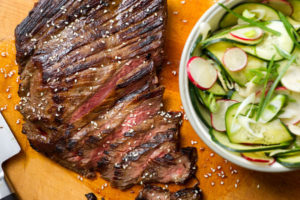To kick of February’s Month of Macros, we’re starting off with a guest post written by one of our lifters, Sarah Chamberlain.
So you’re doing your macros and thinking about how to get enough protein without overloading on calories. But be honest – you might also be thinking “How the hell do I make food taste good without fat and sugar?” Well, I’m here to tell you that there is a lot more to flavor than just sugar, fat, and salt, despite what the makers of junk food want you to think. In the same way that when you paint you have a color wheel to choose from, when you cook you can choose from a wheel of flavors, and mix and match them to your taste. Here are the flavors you should think about:
Umami – You know when you’re eating spaghetti with meat sauce, and it has that huge savoriness that keeps you coming back for more? That flavor is called umami. The name is Japanese and it was originally applied to the taste of Japanese ingredients like miso and soy sauce. (Try buying a package of white miso and using it to glaze fish and chicken before grilling or roasting.) It’s also a flavor note in red meat, tomatoes, Parmesan, olives, anchovies, fish sauce, and mushrooms.
Sour – If life gives you lemons, you can make all kinds of food. Lemon juice and zest gives food more brightness and excitement – try a big squeeze of juice on grilled chicken and fish, but also on roasted vegetables and cooked grains. Limes are also great with Mexican and East Asian flavors. Besides citrus fruits, there are also all sorts of delicious vinegars, beyond just red, white, and balsamic. I keep unseasoned rice vinegar around for making Asian salads.
Bitter – You like coffee, tea, and beer, right? Then you like bitter things. If you want to explore this in your food, check out chicory and endive, and bitter leafy greens like broccoli rabe and dinosaur kale. For a terrific side dish, try sautéing them with a little olive oil, sliced garlic and red chile, and an anchovy or two.
Green/Herbal – This flavor is especially good for cutting through bland food, in combination with sour. A handful of chopped fresh mint, Italian parsley, or cilantro over food livens things up. You can also use chopped scallions and raw serrano chiles. Try blitzing all of these together with green olives and some olive oil in a food processor to make a relish – it’s fantastic with chicken, or with oily fish like salmon.
Aromatic/Spiced – Every soup, stew, and braise recipe you read will start with a base of what chefs call aromatics. The combinations vary across cuisines. For example, you’d use green onions, garlic, and ginger for Chinese food, and shallots, ginger, and lemongrass for Thai food. Similarly, certain cuisines use spice mixes to build lots of deep flavor – the Indian garam masala is a classic example.
A really good, satisfying meal will use multiple flavors to balance and contrast each other. A terrific example that is also loaded with protein is this recipe for Vietnamese flank steak from the New York Times writer Melissa Clark:
Vietnamese Steak with Cucumber Salad
Flank steak is a great cut – not too pricey and with lots of deep, minerally flavor. The combination of sour, green and umami tastes makes this a recipe I come back to again and again. Word to the wise – if you don’t feel like using cucumbers and radishes in the salad, it’s also really good with both shredded cabbage and carrot (think Asian coleslaw), or with peak-season tomatoes. And of course, leftover steak is never a bad thing…
Happy lifting, and bon appetit!
Sarah Chamberlain trains with Bay Strength under SSC Gwyn Brookes. She is a food historian and cook who spends all her time thinking about where her next meal is coming from. When she’s not lifting, she writes about history and culture for the websites Extra Crispy and At the Table. She is also working on her first book, a history of British food culture since 1945.

